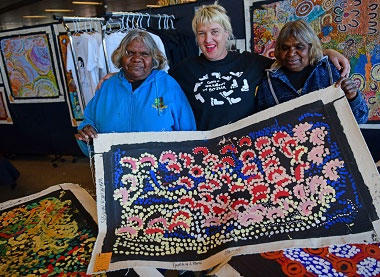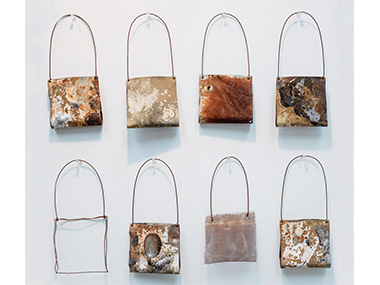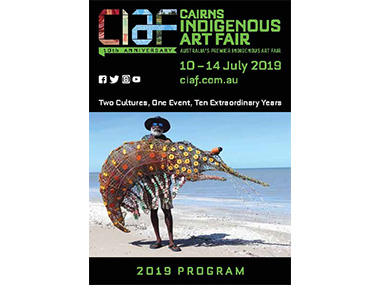FAIRS FAIRS

A customer engages delightedly with remote artists at 2018's National Indigenous Art Fair in Sydney
Posted by Jeremy Eccles | 06.06.19
Dates:
29.06.19
: 30.06.19
Location: Overseas Passenger Terminal on Circular Quay West, Sydney
Have you noticed that no city these days seems to be able to survive without an Aboriginal art fair – held annually? Is this market demand, or is it the demand of the art centres to get more of their (excessive?) output into the market in a way that they can control?
I think it all started with my friend Apolline Kohen deciding that her Maningrida Art Centre couldn't afford a permanent gallery in Darwin, but she could organise a fair where its artists got ethical exposure when the Darwin market was at its hottest – during the Telstra NATSIAAs. It happened in 2007 and 16 art centres joined the party in cramped conditions. Two years later, the State-funded Cairns Indigenous Art Fair began its important existence adding those amazing Torres Strait Islanders to the mix. Perth has been running its WA exclusive 'Revealed' since 2011. Adelaide's Tarnanthi Festival didn't feel it could come into its high-art existence in 2015 without a less high-art fair. Sydney tried a commercial version – which failed; but now, local First Nations facilitators at First Hand Solutions are into their third National Indigenous Art Fair – a bold claim! And then there are now dedicated Aboriginal art Fairs in Canberra and even Lismore.
What's the matter with Melbourne???
Let's examine the claims of the newish National Indigenous Art Fair (NIAF) in Sydney.
First Hand Solutions Aboriginal Corporation developed its Blak Markets model after identifying a series of barriers in the industry and community. These included a lack of Aboriginal and Torres Strait Islander peoples/organisations in decision-making roles within the marketplace which can mean a decrease in economic benefits going directly to artists or organisations working in community to improve outcomes.
Now, as well as the fair itself, First Hand organises three days of professional development for remote artists while they are in Sydney for NIAF. It's part of its Heart in Art program that connects artists with local Aboriginal groups, visits the Art Gallery of NSW, corporate collections, etc. This plays a role in First Hand's cultural exchange between urban and Aboriginal communities where they take urban youth to remote communities to learn from people still connected to Country, where culture is still practised. This knowledge increases pride and resilience in urban youth as they realise they are part of a culture going back 60,000 years.
Head honcho, Peter Cooley from Larper told me he'd just come back from 9 days with 12 Sydney kids around Central Desert communities and found them “screaming for culture – it's so much bigger there than anything they can see at home. They may know they're Indigenous, but they don't who their mob are”.
Later this month, Indigenous artists from 26 remote art centres in the NT, SA and WA are set to come together in Sydney for NIAF – a two-day art market and program of events on 29 & 30 June in celebration of NAIDOC Week at the Overseas Passenger Terminal on Circular Quay West. NIAF is a unique opportunity to buy artwork directly from Aboriginal artists. There will also be a selection of 30 stallholders from around New South Wales selling art, jewellery, gifts, homewares, and Indigenous food and beverages. And a group of remote Aboriginal weavers and fibre artists will create a woven interpretation of the Sydney Harbour Bridge, which will evolve before visitors' eyes.
Confirmed remote art centres are:
APY Art Centre Collective
Artists of Ampilatwatja
Babbarra Women Centre
Bula'bula Arts
Ceduna Art Centre
Fitzroy Women's Collective
Gapuwiyak Culture and Arts
Ikuntji Artists
Iltja Ntjarra Many Hands Art Centre
Martumili Artists
Munupi Arts and Crafts Association
Tangentyere Artists
Tjanpi Desert Weavers
Tjarlirli Art
Warakurna Artists
Warakurna Artists
Warlukurlangu Artists
Warmun Art Centre
Warnayaka Art & Cultural Aboriginal Corporation
NIAF 2019 follows the successful 2018 fair, which hosted 25 remote art centres and saw 15,000 visitors over two days.
And if you thought that was enough fair-going in Sydney, Carriageworks covers the rest of the country with its SOUTHEAST Aboriginal Arts Market, bringing together artists and collectives from regional and coastal New South Wales, the ACT, southern Victoria, the Murray basin catchment and Tasmania, on 9th and 10th of November. It's curated by Hetti Perkins and artist Jonathan Jones.
Next cab off the rank is Cairns with CIAF's 10th-anniversary event. It's Queensland-only Fair (with a number of prizes) is just the start of things there with a fashion show, several curated art shows, performances and the annual symposium on matters of importance to Indigenous art.
At the Cairns Art Gallery, the oddly-entitled 'Queen’s Land Blak Portraiture - Late 19th Century To The Present' exhibition explores the relationships between personal, cultural and national identity in relation to historical and contemporary portrait images by Indigenous and non-Indigenous artists. At the Tanks Art Centre, 'Thancoupie - A Legacy of Cultural Power' is a tribute exhibition to the great Cape York-born potter, who was also CIAF’s founding Patron.
Apart from the Fair's grand opening entertainment on 11th July, the Cairns Performing Arts Centre is putting on a show produced by CIAF to develop a repertoire that has cultural, historical and contemporary significance called 'Cultural Heights'. In the year of Indigenous languages, three choirs sing in Gunggandji, Yidinji, Yalanji, Guugu Yimithirr, Meriam Mir and Kulkalgal Ya. Audiences will be immersed in traditional forms of singing rarely heard outside the community environment, performed in the soaring acoustic setting of the PAC.
In the CIAF Symposium on 10th July, the subject of discussion will be 'Queensland Indigenous Art - From small beginnings to world recognition'. It will feature academics, collectors, artists, designers, curators and sector professionals who will consider the current state of Queensland First Peoples’ art and its future, exploring the many factors that underpin culture, capacity and the contemporary art market.
Indigenous curator Djon Mundine will deliver the Keynote Speech, considering what are the distinguishing features that hallmark Queensland First Peoples’ art? What role does art play in such different remote, rural and urban communities? Can it be defined as a 'movement'? Later, CIAF Director Janina Harding will discuss the beginnings of Torres Strait printmaking in the 1990s, taking it through to today’s contemporary artists working in ceramic sculpture and creative cultural installations.
And after the Fair, you could join a special 4-night voyage on the Great Barrier Reef accompanied by renowned Lockhart River artist Naomi Hobson. Having exhibited nationally and internationally since 2013, Naomi is well known for her ceramics and paintings exploring identity and her country with a highly individual voice. During the cruise, Naomi will share her story and art practice with guests, as well as hosting workshops in hand-built ceramics.
Now to Darwin in August (7th to 9th) where the country's largest Aboriginal art fair is also expanding beyond mere marketing. It has developed an Indigenous Curators Program and Symposium, recognising that “there has been a growing number of Indigenous curators (emerging & established) who visit our event each year and play a crucial role in supporting, mentoring and encouraging the Aboriginal & Torres Strait Islander artists and Arts Workers that attend our event. So, 20 subsidised places and 20 non-subsidised places for Indigenous curators are available to participate in a 3-day program.
And the Fair itself should be a hum-dinger for the latest round of the NT's Community Benefits Fund grants has delivered $240,000 over three years “to bring a vast collection of works and the artists to the event that is a significant attraction for tourists”.
In Canberra, you have to wait until December (6th/7th) for the sixth iteration of the AIATSIS Indigenous Art Market which will have more art stalls, food, hot and cold beverages, music and workshops than previously. But, strangely for Canberra, it leaves out the politics!
This is simply “An unparalleled opportunity for our local community to encounter, engage, and be transformed by Aboriginal culture from around Australia. When you choose to buy authentic products direct from these community markets, you are supporting Aboriginal people in local and remote communities. So come along and buy authentic Aboriginal art, crafts, fashion and jewellery.”
Share this:
»  del.icio.us
»
del.icio.us
»  Digg it
»
Digg it
»  reddit
»
reddit
»  Google
»
Google
»  StumbleUpon
»
StumbleUpon
»  Technorati
»
Technorati
»  Facebook
Facebook
Contact Details

'Narrbong' (String Bag)by recycling artist Lorraine Connelly-Northey at the SE Aboriginal Arts Market in Carriageworks, 2018. Image Dan Boud

Sid Bruce Short Joe from Pormpuraaw Art & Culture Centre stars in the CIAF 2019 poster with a ghost net creation of a crustacean nature.
Further Research
Artists: Jonathan Jones | Lorraine Connelly-Northey | Naomi Hobson | Sid Bruce Short Joe | Thancoupie
News Tags: Apolline Kohen | Cairns Indigenous Art Fair | CIAF | DAAF | Djon Mundine | First Hand Solutions | Jeremy Eccles | NIAF | Peter Cooley | Telstra NATSIAAs
News Categories: Art Fair | Art Prize | Australia | Blog | Event | Exhibition | Feature | Festival | Industry | News
Exhibition Archive
- 06.06.19 | FAIRS FAIRS
- 05.06.19 | NY is the Epicentre
- 30.05.19 | Namatjira Wins the Ramsey
- 20.05.19 | The Gagosian Effect
- 13.05.19 | INTERESTING TIMES
- 03.05.19 | GAGOSIAN OPENING TONIGHT
- 02.05.19 | WHO'LL WIN THE WYNNE IN 2019?
- 01.05.19 | Telstra NATSIAA finalists announced
- 14.04.19 | Gagosian Goes Aboriginal
- 10.04.19 | An Indigenous Biennale?
- 30.03.19 | Kunmanara Williams Stars at The National
- 27.03.19 | Parrtjima and CIAF announce 2019 plans
- 19.03.19 | Jarinyanu David Downs Collection Heads to NT
- 14.03.19 | TJUNGUNGUTJA TO ALICE
- 26.02.19 | THE WEST
Advertising

